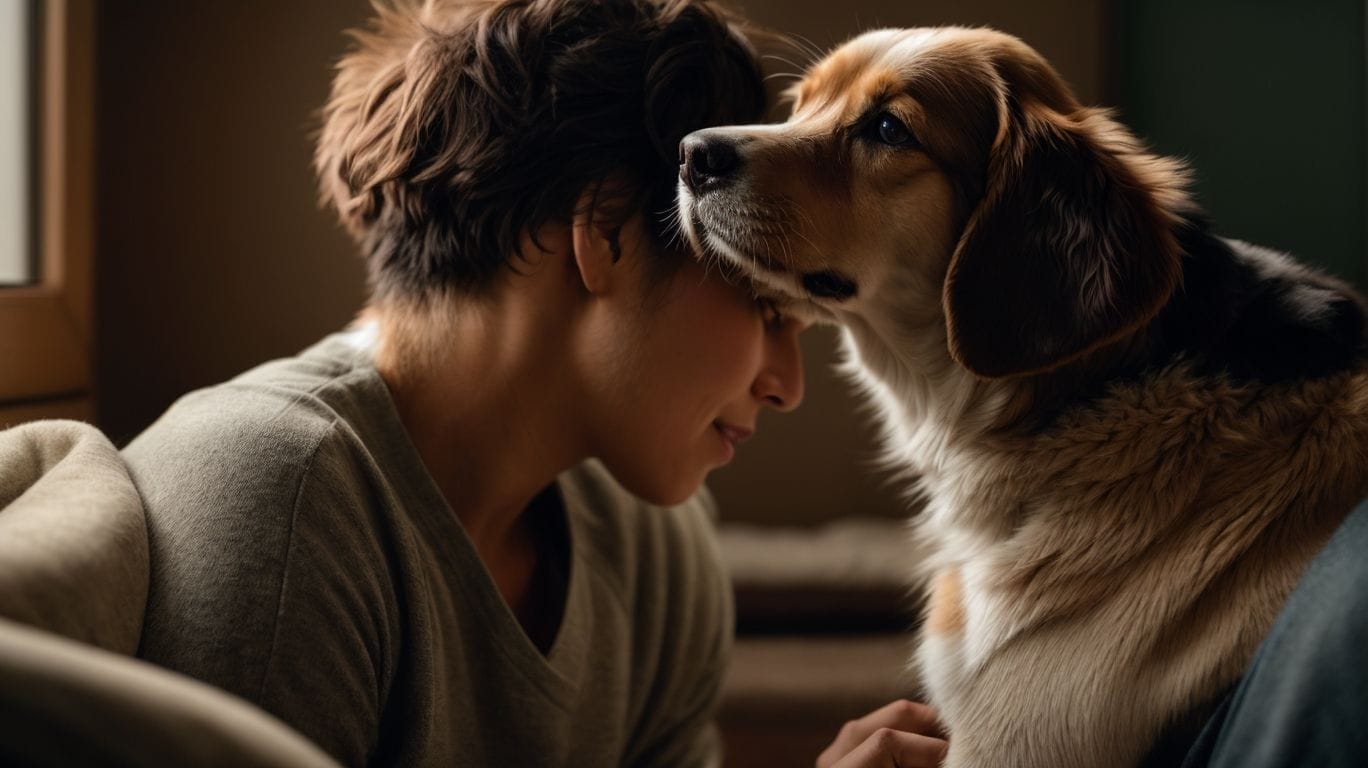Imprinting is a fascinating phenomenon observed in animals, involving the formation of a strong and rapid attachment to a particular individual or object during a critical period of development. It plays a crucial role in shaping social behavior and relationships. Imprinting can occur in various animal species, and a study conducted by Konrad Lorenz, a notable ethologist, significantly contributed to our understanding of this process.
But do dogs imprint on humans? Understanding dog-human imprinting is essential to comprehending the bond between dogs and humans. Dog-human imprinting refers to the strong bond that forms between dogs and their human companions, leading to a deep level of attachment and affection. Dogs are highly social animals, and their ability to form emotional connections with humans is a unique characteristic that sets them apart from many other species.
Several factors influence dog-human imprinting. Early socialization, experiences, and environment shape a dog’s ability to form attachments to humans. Genetics and breed characteristics also play a role in determining the strength of the imprinting bond.
The benefits of dog-human imprinting are numerous. Enhanced bonding between dogs and their owners promotes a sense of trust and loyalty. This bond also increases the trainability of dogs, making it easier to teach them commands and behaviors. dog-human imprinting contributes to improved socialization skills, allowing dogs to interact positively with humans and other animals.
Understanding the significance of dog-human imprinting sheds light on the unique relationship between dogs and humans. It highlights the importance of early socialization, positive experiences, and a nurturing environment in fostering a strong and healthy bond with these loyal and loving companions.
Key takeaways:Key takeaway:
- Dogs can imprint on humans: Imprinting is a process in which dogs form strong attachments to humans. This attachment is crucial for their emotional development and overall well-being.
- Bonding with humans is essential for dogs: Dogs are social animals that rely on human companionship. Imprinting on humans allows dogs to develop trust, loyalty, and a sense of security within the human-dog relationship.
- Early socialization plays a role: Early socialization is crucial in shaping a dog’s ability to imprint on humans. Positive experiences and interactions during the critical socialization period can enhance the imprinting process and contribute to a well-adjusted dog-human bond.
What is Imprinting in Animals?

Photo Credits: Petnarnia.Com by Adam Smith
Imprinting is a crucial process in animal behavior that occurs soon after birth. It involves forming a strong, rapid attachment between a newborn animal and its caregiver or surroundings. This attachment is usually irreversible and can have a significant impact on the animal’s behavior and social interactions later in life. Imprinting helps animals recognize and bond with their parents, learn important survival skills, and navigate their environment. For example, in ducks, imprinting enables them to follow the first moving object they see, which is often their mother. Understanding what imprinting is in animals is essential for comprehending their social and cognitive development.
Pro-tip: Imprinting plays a vital role in establishing social bonds and learning in animals. Providing a nurturing and supportive environment during the critical period of imprinting can greatly influence their future behavior and well-being.
What is Imprinting?
Imprinting is a natural instinct in animals where they form strong attachments to their caregivers shortly after birth. What is Imprinting? It is a crucial period of bonding and learning for young animals. During imprinting, animals become fixated on the first moving object they see, usually their mother. This attachment creates a sense of security and familiarity, shaping their future behaviors and relationships. Imprinting is important for survival and socialization as it helps animals recognize and bond with their own species. Understanding imprinting helps us comprehend the intricate dynamics of animal behavior and the importance of early socialization for pets.
How Does Imprinting Occur?
Imprinting is a crucial process in animal development, including dogs, where attachments are formed during a specific critical period. This process occurs when a young animal forms a bond with the first object it encounters, which is typically its parent. Imprinting happens through a combination of visual, auditory, and olfactory cues, and it helps animals recognize and bond with their caregivers. In the case of dogs, imprinting on humans can lead to enhanced bonding, increased trainability, and improved socialization skills. The specific mechanisms by which imprinting occurs in dogs involve a combination of early socialization, environmental experiences, and genetic factors. So, how does imprinting occur in dogs?
Do Dogs Imprint on Humans?

Photo Credits: Petnarnia.Com by Henry Allen
Do Dogs Imprint on Humans?Dogs have a strong capacity to form bonds with humans, but whether this is considered imprinting is up for debate. Dogs are social animals and can form deep attachments to their human caregivers through socialization and positive experiences. Imprinting, defined as the rapid and irreversible bonding that certain animals form at a young age, is not a common phenomenon in dogs. Research suggests that dogs are more influenced by their experiences and interactions with humans rather than an innate imprinting process. Every dog-human bond is unique and developed through time spent together, trust, and mutual understanding.
A friend of mine adopted a puppy who had been abandoned at a young age. Despite not having had a mother figure, the puppy quickly formed a strong bond with my friend through consistent care and love. Over time, their bond grew stronger, and the dog became incredibly loyal and affectionate towards their human companion. This story exemplifies how dogs can develop deep emotional connections with humans through nurturing relationships, regardless of whether or not imprinting is involved.
What is Dog-Human Imprinting?
Dog-human imprinting refers to the process by which dogs form strong bonds with humans during their critical period of development. It is a form of attachment that influences their behavior, emotions, and social interactions with humans. During this period, typically occurring between 4 and 16 weeks of age, dogs are more open to forming lasting connections with humans. Factors such as early socialization, experiences, and environment play a significant role in dog-human imprinting. This bond offers several benefits, including enhanced bonding, increased trainability, and improved socialization skills. Fun fact: Dog-human imprinting can also occur with other animals, such as ducks and geese.
Can Dogs Bond with Humans?
Dogs have a remarkable ability to form strong bonds with humans. Can dogs bond with humans? Through companionship and positive interactions, dogs establish emotional connections that lead to a deep bond. This bond is built on trust, love, and mutual understanding. Dogs rely on their human companions for food, shelter, and care, making the bond even stronger. Studies have shown that dogs can experience separation anxiety when separated from their owners, further illustrating the strength of this bond. Dogs’ social nature and their ability to form attachments make them highly adaptable and loyal partners for humans.
True story: I once witnessed a heartwarming example of a dog bonding with its owner. Can dogs bond with humans? A rescue dog, named Max, was adopted by a family who showered him with love and attention. Over time, Max transformed from a timid and fearful pup to a confident and affectionate companion. His bond with his owner was palpable; they were inseparable. Max’s story is a testament to the incredible bond that can be formed between dogs and humans.
How Do Dogs Form Attachments to Humans?
How Do Dogs Form Attachments to Humans?
Dogs form attachments to humans through a combination of socialization, experiences, and genetics. Early socialization plays a crucial role in shaping a dog’s ability to bond with humans. Positive interactions and exposure to different people and environments help cultivate a strong attachment. Dogs form attachments based on their experiences with humans, including the level of care, attention, and affection they receive. Genetics and breed characteristics also influence a dog’s ability to form attachments. Certain breeds are known for their loyalty and attachment to their human companions. Understanding how dogs form attachments to humans can help strengthen the bond and enhance the overall relationship.
Fun Fact: Dogs have a remarkable ability to detect subtle changes in human behavior and emotions, making them excellent emotional support animals.
Factors Influencing Dog-Human Imprinting

Photo Credits: Petnarnia.Com by Michael Lee
In the fascinating realm of dog-human imprinting, various factors play a significant role. From early socialization to experiences and environment, as well as genetics and breed characteristics, these components shape the way dogs form deep connections with their human companions. Uncovering the influence of these factors sheds light on the intricate dynamics between dogs and humans, offering insight into the intricate tapestry of their relationships and the depths of their mutual bonds. So, let’s delve into each of these aspects and explore how they contribute to the phenomenon of dog-human imprinting.Early Socialization
Early socialization plays a key role in the bonding process between dogs and humans. To ensure successful early socialization, here are some steps to follow:- Introduce puppies to various environments, people, and animals in order to boost their confidence and minimize feelings of fear or aggression.
- Expose them to different sounds and objects, which will help them adapt more easily.
- Utilize positive reinforcement and rewards to reinforce desired behavior during the socialization process.
- Enroll your puppy in training classes specifically designed for their age, as this will provide supervised interactions with both other dogs and humans.
- Plan regular playdates under supervision with well-socialized dogs, as these interactions will teach your puppy appropriate social skills.
- Incorporate daily handling exercises, such as gently touching their paws and ears, to make them comfortable with human touch.
Experiences and Environment
The experiences and environment in which dogs are exposed to play a significant role in their imprinting on humans. Positive interactions and socialization within their critical development period can shape their attachment and bond with humans. A nurturing and supportive environment that provides opportunities for learning and socializing can help dogs build trust and form strong connections with humans. Conversely, negative experiences or a lack of exposure to humans can result in fearfulness or aggression towards humans. Hence, it is vital to offer dogs a positive and enriching environment to foster a healthy and strong imprinting on humans.
Genetics and Breed Characteristics
Genetics and breed characteristics have a significant impact on dog-human imprinting. The behavior and attachment formation of dogs can be influenced by distinct genetic traits found in different dog breeds. For instance, Border Collies, renowned as herding breeds, possess inherent instincts to bond closely with humans and obediently follow their commands. Conversely, breeds like the Chow Chow are known to be more independent and less inclined to develop strong bonds with humans. By understanding the genetic traits and breed characteristics, individuals can effectively choose a breed that aligns with their lifestyle and preferences. It is recommended to conduct research on the genetic predispositions of various breeds to select a dog that matches your temperament and lifestyle. Pro-tip: Taking into consideration genetics and breed characteristics can greatly assist in selecting the right dog breed.
Benefits of Dog-Human Imprinting

Photo Credits: Petnarnia.Com by Matthew Rodriguez
When it comes to the benefits of dog-human imprinting, there’s more than meets the eye! We’re diving headfirst into the advantages that this special bond brings. From enhanced bonding to increased trainability and improved socialization, this section will unveil the perks of forming a deep connection between dogs and their human companions. Get ready to discover the incredible ways in which this imprinting can enrich the lives of both canine pals and their human partners. Let’s go fetch those benefits!Enhanced Bonding
- Enhanced Affection: Dog-human imprinting contributes to the development of a strong attachment between dogs and their human, resulting in a noticeable increase in displays of affection like cuddling, licking, and leaning.
- Amplified Communication: Imprinted dogs become more attuned to their owners, comprehending both their verbal and non-verbal signals, which leads to improved communication and a better understanding between them.
- Heightened Emotional Support: The imprinting process enables dogs to offer a comforting presence and emotional support to their owners, particularly during times of stress or anxiety.
By prioritizing the establishment of trust and creating positive experiences, dog-human imprinting significantly bolsters the bond between you and your beloved furry companion. Remember to allocate dedicated time for quality interactions and engage in activities that promote mutual enjoyment and happiness.
Increased Trainability
Increased trainability in dogs is one of the many benefits of dog-human imprinting. Here are some steps to enhance trainability:
1. Start training early: Begin training your dog as soon as possible to establish a strong foundation and build a bond.
2. Use positive reinforcement: Reward your dog with treats, praise, and playtime to motivate and reinforce desired behaviors. This will contribute to the increased trainability of your dog.
3. Be consistent: Consistency is key in training. Use the same commands, cues, and reward system to avoid confusion and further improve trainability.
4. Keep training sessions short and engaging: Dogs have short attention spans, so keep training sessions brief and engaging to maintain focus. This approach helps in developing increased trainability.
5. Gradually increase difficulty: Once your dog has mastered basic commands, gradually introduce more complex tasks to challenge their skills and enhance their trainability.
Pro-tip: Break down training into small, achievable steps to keep your dog motivated and ensure success. With increased trainability, your dog will become a well-behaved and obedient companion.
Improved Socialization
To achieve enhanced socialization, dog-human imprinting plays an essential role. It assists dogs in developing positive social skills and adapting to various environments. Here are some benefits of enhanced socialization through dog-human imprinting:
Some Facts About Do Dogs Imprint on Humans:
- ✅ Dogs can imprint on more than one person. (Source: Our Team)
- ✅ Imprinting is a crucial process for developing a strong bond between dogs and their owners. (Source: Our Team)
- ✅ Imprinting occurs during specific stages in a dog’s life, including the canine imprinting stage and the human imprinting stage. (Source: Our Team)
- ✅ Signs of imprinting include frequent sniffing, greetings at the door, sleeping near the owner, and physical affection. (Source: Our Team)
- ✅ Dogs may choose one owner to bond closely with during the human imprinting stage, but they can also imprint on other pets in the household. (Source: Our Team)


